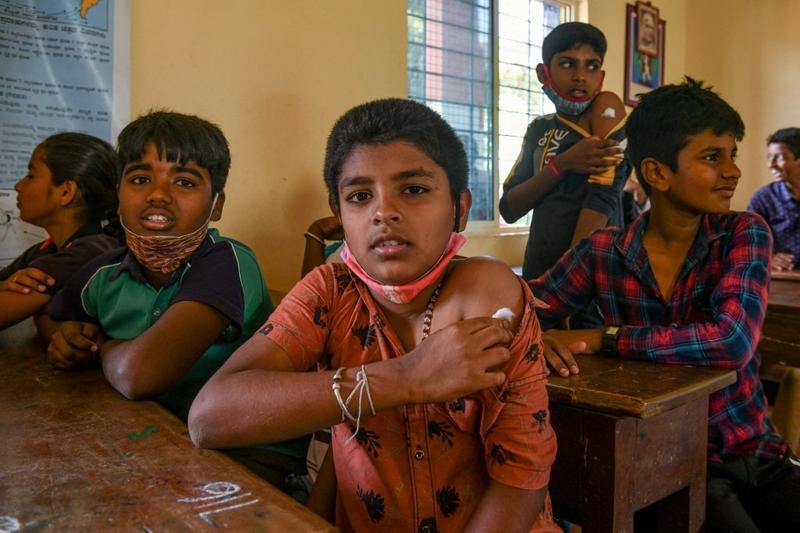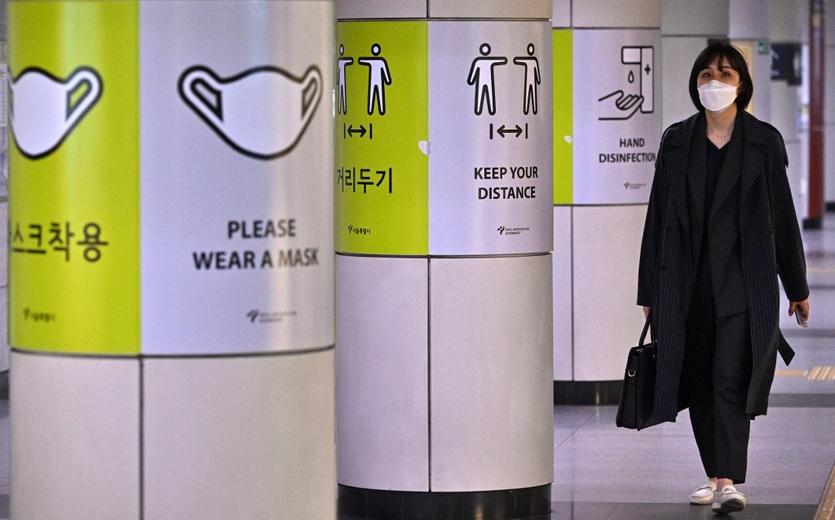 Students inoculated with a dose of 'Corbevax' vaccine wait inside a classroom for observation, during a vaccination drive held for children in the age group of 12-14, as a preventive measure against COVID-19 coronavirus disease in Bangalore on March 30, 2022.
(MANJUNATH KIRAN / AFP)
Students inoculated with a dose of 'Corbevax' vaccine wait inside a classroom for observation, during a vaccination drive held for children in the age group of 12-14, as a preventive measure against COVID-19 coronavirus disease in Bangalore on March 30, 2022.
(MANJUNATH KIRAN / AFP)
NEW DELHI / SEOUL / WELLINGTON - India's tally of daily COVID-19 cases nearly doubled on Monday from the previous day to more than 2,000 for the first time in a month, government data showed, and the southern state of Kerala reported a big jump in deaths.
India was at the centre of the global COVID crisis this time last year but the situation has improved since then and most precautions including the wearing of masks have recently been dropped.
India was at the centre of the global COVID crisis this time last year but the situation has improved since then and most precautions including the wearing of masks have recently been dropped
But cases have been creeping up in the country of 1.35 billion people, with 2,183 new infections reported on Monday, taking the running total to more than 43 million, according to health ministry data.
The ministry reported 214 more deaths, including 151 since April 13 in the southern state of Kerala, which is widely considered to issue more accurate data than many other states.
ALSO READ: Virus: India 'mulls widening booster effort to all adults'
India has reported a total of about 522,000 deaths from the coronavirus though many global experts have said its real death toll could be up to 4 million, from several hundred million cases.
Prime Minister Narendra Modi's government has repeatedly rejected those higher estimates saying the mathematical models used to estimate deaths in smaller countries cannot be relied on for India. read more
Apart from Kerala, the capital, Delhi, and the states of Maharashtra and Haryana reported triple-digit increases in infections in the past 24 hours.
However, hospitalizations remained low though those numbers have also been inching up over recent days since all restrictions were dropped.
New Zealand
New Zealand recorded 6,242 new community cases of COVID-19 on Monday, the country's Ministry of Health said in a statement.
Of the new community infections, 453 were detected in the largest city of Auckland, which saw a great decline in infections from last week, according to the ministry.
In addition, 41 new cases of COVID-19 were detected at the New Zealand border, said the ministry.
Currently, 553 patients are being treated in New Zealand hospitals, including 23 in intensive care units. The ministry also reported 11 more deaths from COVID-19.
New Zealand has reported 828,906 confirmed cases of COVID-19 since the beginning of the pandemic in the country.
The country is currently at the second-highest Orange setting under its COVID-19 Protection Framework.
Under Orange there are no indoor capacity limits and the seated and separated rule for hospitality venues lifts, when bars, cafes and restaurants are able to fill up again. However, people are required to wear a face mask in many indoor settings.
 A woman walks past posters showing precautions against the COVID-19 coronavirus at a subway station in Seoul on April 15, 2022. (JUNG YEON-JE / AFP)
A woman walks past posters showing precautions against the COVID-19 coronavirus at a subway station in Seoul on April 15, 2022. (JUNG YEON-JE / AFP)
South Korea
South Korea lifted almost all of its COVID-19 precautions on Monday in a major step towards a return to normal life as the Omicron variant recedes and daily infections retreated to a more than two-month low of fewer than 50,000.
A midnight curfew on restaurants and other businesses was scrapped, along with a cap of 10 people allowed to gather. From next week, people will be allowed to eat snacks in cinemas and other indoor public facilities such as stadiums.
People are still required to wear masks, however, with the government planning to review whether to lift a rule for masks outdoors in two weeks.
The relaxation of the rules come as the number of coronavirus cases in South Korea fell to 47,743 on Monday, the lowest since Feb 9, after hovering at more than 620,000 a day in mid-March
The relaxation of the rules come as the number of coronavirus cases in South Korea fell to 47,743 on Monday, the lowest since Feb 9, after hovering at more than 620,000 a day in mid-March.
ALSO READ: S. Korea to offer COVID-19 vaccines to children aged 5-11
Some rules, however, remain including mandatory quarantine for unvaccinated inbound travelers and negative PCR tests for the fully vaccinated.
South Korea has largely managed to limit deaths and critical cases through widespread vaccination, and it has scaled back the aggressive tracing and containment efforts that made it a mitigation success story from most of the first two years of the pandemic.
Nearly 87 percent of the 52 million population are fully vaccinated, with 64 percent having also had a booster, according to Korea Disease Control and Prevention Agency data.
In line with the easing of the rules, companies are gradually returning to their offices.
Most staff at giant steelmaker POSCO have returned to their offices this month, becoming one of the first major firms to bring people back.
LG Electronics said it had reduced the proportion of employees working from home to 30 percent from 50 percent from Monday, while scrapping a limit on the number of people allowed in meetings.
Samsung Electronics said it had yet to implement its back-to-office plan and the public sector is also awaiting new government guidelines.
The Bank of Korea, which has 30 percent of its head office staff working from home, is considering easing its guidelines, officials said.
The government had recommended workplaces with 300 or more employees adopt flexible working hours and have 10 percent of staff work from home.


